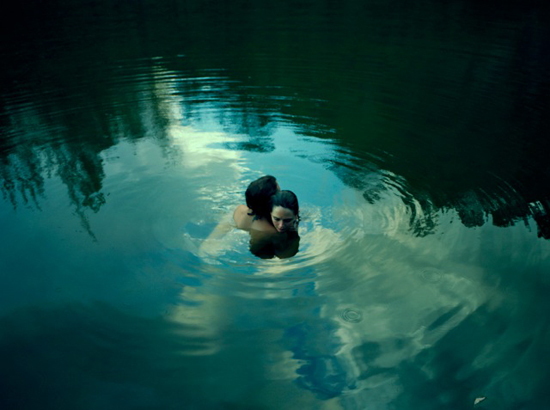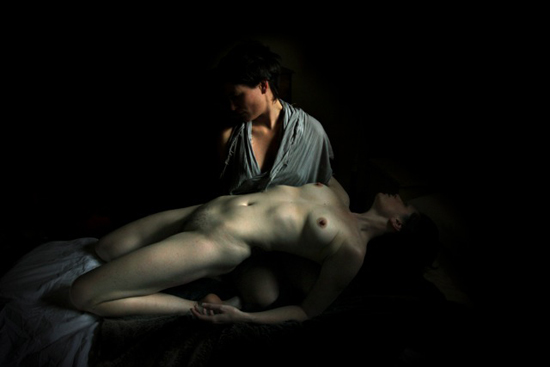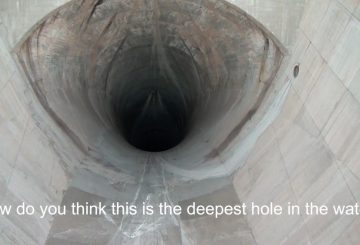Sharne Wolff chats with Tamara Dean about her new show, her influences and ‘environmental composition’…
Sharne Wolff: Your first show with Tim Olsen Gallery has recently opened in Sydney. Can you tell us a little about the photographs included in this exhibition?
Tamara Dean: The photographs in this exhibition are from my most recent series ‘Only Human’. This body of work explores the notion that we are indeed ‘Only Human’. It depicts the human body in such a way as to reveal its fragility and vulnerability. I am also interested in the relationship between humans and nature, or more specifically the Australian bush. How we interact and engage with the natural world and with each other.
Tamara Dean, Centre of the Universe. Courtesy of the artist, Tim Olsen Gallery and James Makin Gallery.
SW. I’m interested in hearing about the human subjects (including the children) in your photographs…do you ask friends and family, or use paid models?
TD: Usually my works feature my friends and family, the people closest to me. I have approached people I don’t know in the street who have a particular look which struck me but this is more unusual. I find that by photographing the people closest to me there is already an understanding and a sense of intimacy that make the unguarded moments I am trying to capture more accessible.
SW. Many of your portraits capture intimate and seemingly honest moments between your subjects. How do you manage to achieve this kind of reality?
TD: I do this by bringing my subject/s to a location (which at times has significance to them). I give them a general idea about what I am trying to express conceptually through the image and the series, and then just spend time creating an intimate, comfortable space which allows the real relationships to bring the integrity to the construct. The reason it appears honest is that it is – the people in the photographs are interacting naturally. I give a certain amount of direction but encourage my subjects to bring their relationship into the narrative.
SW. Landscape is obviously a very important element in your work. Do you have any favourite places to shoot? Is the way the landscape portrayed as important to you as the human element?
TD: I love to photograph around Hill End. The landscape is critically important as I see it as another character in the relationships I am depicting. Whilst the people are interacting with each other they are also interacting with the landscape. I set them in the natural landscape to strip them of contemporary artifice and to bring a sense of universality to the narrative. The bush or wilderness represents the primal world. The posturing of the body, the power relationships depicted, the clothing and body markings are the signifiers of the contemporary world.
SW. When on a shoot do you generally have a very specific idea of composition or is it more of a process led by environmental or other factors on the day?
TD: I do both. At times I have a specific idea of the composition such as the more formal landscapes whereby the human figures form a small part but my favoured way of working is to keep it an intuitive process which is informed by environmental factors and emerging narratives through the process of the shoot. I do tend to work out the environmental part of the composition ahead of time but try to keep the human element remaining fluid.
Tamara Dean, Only Human. Courtesy of the artist, Tim Olsen Gallery and James Makin Gallery.
SW. As many readers would be aware, you have a ‘day job’ as a photographer with the Sydney Morning Herald. How do you think this affects your artistic practice – or do you see all your work as ‘art’?
TD: I do have a very clear separation between my artistic practice and my work as a photographer for the SMH although they certainly influence each other. When I work for the paper I have little control over who, when and where I am to photograph which keeps me alert to looking for interesting light and moments emerging from very new relationships and in a very short period of time. I have to be directive, attentive and incredibly alert to capturing an unguarded and spontaneous moment. This is great training of the eye but more importantly of timing, and without it I think it would be easy to miss important images. My SMH photographs can be artistic but I see them as different to my art practice as for the most part I am responding to what I have been assigned to and to what is happening in front of me rather than creating it. Within my artistic practice I bring all of this training but am in control of who, what, when and why. And certainly, my particular aesthetic imbues the photographs I take while working for the SMH.
SW. Do you work in digital format? And, for all the photographers out there – do you have a favourite camera or generally use any particular lens?
TD: I work with both a digital camera and medium format film camera.
SW. Most of your work, including much of the recent Herald photography is very concerned with the dramatic entry of light into the photograph. Without giving away any secrets, could you tell us how you manage to achieve this?
TD: I choose a particular time of day in which to shoot that gives the sense of luminescence to the human figure. I have a window of about 10 minutes of the ‘perfect’ light in which to attain my image/s. But I spend an hour or more setting people at ease and building up to that window of time.
SW. Do you need to use any digital manipulation in your photographs? How involved are you in end result?
TD: I do as little manipulation as possible these days, I have found over time that it is much easier to try and attain the perfect result in-camera.
SW. Which artists have influenced your work?
TD: The Pre-Raphaelites John William Waterhouse and Rembrandt heavily influence my work. I’m also influenced by photographers Desiree Dolron, Mary Ellen Mark and Eugene Richards.
SW. Most of the human figures in your recent practice are women. You seem to be able to achieve a delicate balance that allows your subjects to be feminine and romantic, without letting them appear powerless or overly sexualised. Do you agree? And do you have any comments about the feminist side of your work?
TD: I’m glad you read this from the images as I went into this particular series with the intention of creating works which depict intimacy between women without being sexualised. I wanted to show the strength women draw from one another, our ability to support and nurture. I am interested in the power and resilience of women.
SW. You’ve been part of the Oculi photographic collective for around ten years now. Has being a part of that collective influenced your practice and/or assisted your work? If so, can you explain how?
TD: Coming in to Oculi in 2002 was hugely influential in my development, which began in the realm of documentary photography. Oculi created an invaluable platform, which allowed (and continues to allow) us to show our personal work as we wish it to be seen. This played a huge part in building my confidence and my style.
SW. Where to next for you?
TD: I have embarked upon my Masters (in Fine Arts – Photography) this year at the ‘National Art School’ and am heading off on two artists residencies, at ‘The Lock-up’ in Newcastle and Hill End in the next 6 months.
Tamara Dean
‘Only Human’
Until 13 May 2012 (as part of the Head On Photo Festival).
Tim Olsen Gallery, Sydney.




Pingback: An Interview with Tamara Dean… « Wolff.